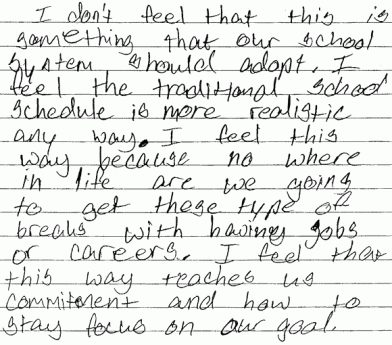In about a month, hundreds of students and parents will be flooding the stores for the annual ritual of back-to-school shopping. When they get home, houses will abound with the smell of blank paper and the sound of shrink-wrapped folders being opened. The old school crowd (like me) will convert brown paper grocery bags into book covers for history, math, and biology textbooks. I still remember the excitement of walking into class on the first day of school (wearing a carefully chosen outfit) with my brand-new, freshly sharpened pencils at the ready. The crisp autumn breeze would dismiss the lazy days of summer and declare the beginning of a new school year. Even the symbol of an apple for the teacher hints at the agrarian calendar on which most of our school systems are based.
But is the traditional school schedule, nine months on, three months off actually ideal? I’m not really sure. (You may have guessed by now that I often enjoy playing devil’s advocate with these ideas.)
Some of the arguments in favor of year round education (YRE) include:
- Frequent breaks provide students and teachers opportunities to recharge and return to school refreshed and ready to learn and teach.
- Having a series of shorter breaks rather than a 3 month break in the summer
may improve retention of the material studied throughout the year. Without a huge gap in which students forget everything they’ve learned, they don’t need to spend as much time reviewing and can therefore spend more time learning new material. - YRE schools can accommodate more students by placing different groups of kids on different tracks.
- Families with kids on the same track often develop a strong bond and rapport with the teachers on that track.
- Breaks scattered throughout the year can be convenient for family vacations.
On the other hand:
- What if families end up with kids on different tracks? Not so convenient anymore.
- Having more student traffic throughout the school year increases maintenance costs.
- Teacher collaboration opportunities could be limited when teachers are on different tracks.
- The lack of an extended summer break closes the door on some summer camp and teen employment opportunities.
- Teachers pursuing continuing education/training efforts often offered in the summer would need to find other opportunities for further training–that scheduling could get complicated.
The YRE issue is one without a clear best option. In reading up on it, the general vibe I’m getting is that if it were to be successful, it would have to be a universal undertaking. If only a few schools opted for the YRE route, they would be out of sync with the rest of their districts and conferences for things like sports and festivals. If elementary schools were on board, but high schools weren’t, families with students in both schools wouldn’t have many opportunities to travel because someone would always be in school.
Personally, I’d like to see how this arrangement would work if everyone gave it a shot. Doing things the way they’ve always been done for the sake of tradition when the cause for doing things that way has expired doesn’t seem like a compelling enough argument.
As a teacher, I’d like to see the time spent in the classroom utilized to maximum effectiveness. The last few weeks of school before summer are typically thrown away because the teachers are tired and daydreaming about summer just as much as the kids. The energy and resolve that characterizes the beginning of the school year often wanes before the first break comes along. I think the much needed recharge for students and teachers by having more frequent breaks outweighs the maintenance costs and scheduling inconveniences. Teaching is a high energy job and learning is a high energy endeavor. In the marathon of a child’s education, it seems intuitive that a more consistent schedule would be a more enjoyable experience that would also yield more lasting results. It’s almost like a tortoise and the hare story–sprint September to May and sleep June through August or progress steadily all year.
I am a product of the traditional school schedule and it definitely worked for me. I LOVE summer and probably would have thrown a fit if my summers had been threatened by educational activists who thought they knew what was good for me. So maybe it’s just my experiemental mentality that wants to see this in action, maybe despite having grown up where the grass is green, I can’t help but wonder how green it actually is on the other side. By the end of summer break, I was always so ready to jump back into school–maybe that motivation would wane if kids were in school all year. Like I said, I don’t have the answers. But I’ve shared my ideas. And as always, yours are welcome here.













